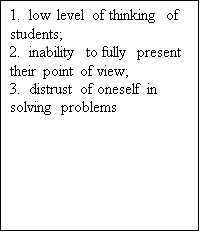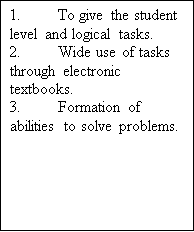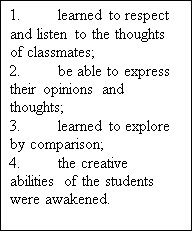In this article methods of application of the critical thinking model in the teaching of computer science are analyzed.
Key words: mobility, sentimentality, consciousness, self-censorship, declamation.
The law of the Republic of Kazakhstan «About education» includes the national and universal values education, creation of necessary conditions for education, the introduction of new learning technologies, as well as upgrading and further development of the education system. In order to enter into the world educational space, Kazakhstan created a new system of education. These innovations, along with the actual developments in the theory of pedagogy and the educational process, requires a new perspective on existing educational activities in the country, critically assess achievements and develop the creative potential of young people, develop new thinking skills and organize new activities of teachers. The theory of critical education is based on the conclusion that the development of students' thinking is interlinked with their previous knowledge and points of view acquired from a new class of sources, teachers, textbooks and peers. An important factor in literate learning is that the teacher can understand and assess the pupil's ability to master the subject. That's why Shulman says that the qualities he calls «the three assistants» are profitable and effective only if he is a teacher.
Three assistants: head, hand, heart. It should be noted that traditional knowledge can be taken into account when assessing the effectiveness of exams. I learned how effective the program is for the student, and how important it is in education and upbringing. That's why «East Aristotle», our ancestor Al-Farabi, was right here. The English were deeply rooted in learning. Shulman, a research psychologist, describes his qualities as «three assistants to the Teacher». General — professional understanding, access — practical teaching skills, cardio-professional-moral integrity. Much here is that each teacher is able to show compassion and to the students with a sincere desire to combine theory and practice. To abolish the punishment of a child who received the "2" rating that was popular in the Soviet era, grant the student freedom of thought and freedom of expression. One of the constructive policies of the Head of State today is the upbringing of modern youth, increasing the competitiveness of young people.
To increase the interest of students, it is necessary to demonstrate their skills using different methods. Critical thinking is not a test, but a creative thought.
One of the most commonly used modules in schools today are the methods used to build students' critical thinking skills. Critical thinking is the most important pedagogical concept, which is important for the development of education in Kazakhstan. This module is designed to help students and teachers develop critical thinking in a conscious and thoughtful way.
Critical thinking is an objective decision aimed at thinking, evaluating, analyzing and synthesizing information obtained through observation, experience, thinking and discussion. This can serve as a basis for action in the future. Often oppose critical thinking, alternative thinking, decisions and actions should be prepared for the introduction of new or modified approaches, social activities and means are organized to tame others to think critically.
The creation of an educational system based on quality education and world-class knowledge is a key issue in the information society in which we live, in a competitive environment in a multicultural environment, with a global approach to securing global education at a high international level. As a first step, the teaching staff of the country passes three levels of training, which teaches the «Cambridge Method». Although this program has different approaches, it has a pragmatic (constructive) theoretical approach.
The theoretical basis of the Cambridge approach is to get to know and learn that new teaching methods — using seven modular lessons — have many advantages and benefits in education.
Choosing critical thinking, our goal is to study, control, listen and analyze ways to increase interest in the subject in computer science, teaching students critical thinking. That's why I think it's better to use the technology of critical thinking in the field of informatics. To achieve the goal, the following objectives are set:
‒ formation of critical thinking skills;
‒ use of interesting practices and new technologies to increase interest in the subject;
‒ awakening the content and self-awareness of students;
When it comes to accomplishing this task, it is understood that a critical approach to the lesson is crucial. We came to traditional studies so that the students could freely sit, talk freely, reflect and analyze. Currently, we use the Bloom taxonomy to plan lessons.
Critical thinking gives the idea of «thinking about thinking». This module allows you to discuss important issues and be effective for your education. This also implies that both the student and the teacher have a conscious and thoughtful approach to the development of critical thinking. Critical thinking is an objective decision aimed at thinking, evaluating, analyzing and synthesizing information obtained through observation, practice, thought and discussion. Critical thinking often implies the ability to oppose, make alternative decisions, be ready to introduce new or changed approaches to our thinking and actions, to organizing social action and critical thinking. The easiest way to do this is to encourage children to focus on the evidence of personal experience.
Critical Thinking— The most important pedagogical concept, which is important for the development of education in Kazakhstan. This module assumes that student and teacher have a conscious and thoughtful approach to the development of critical thinking (Figure 1).
![]()
![]()
![]()


Figure 1
In developing a common understanding of critical thinking, it is necessary to develop a process of critical thinking at a basic level, including:
‒ collection of information;
‒ critical analysis and evaluation of arguments;
‒ clear evidence, conclusions and decisions;
‒ forecasts and suggestions;
Learning to think critically of students in the classroom, that is, monitoring, analysis, conclusion, provides for ways of interpreting, developing critical thinking through dialogue, discussions and education of students, in discussing their mechanical memorization, recitation, exposition, conversation, dialogue, as well as the quality and content of history, including the importance of critical thinking of students, critical thinking of teachers, reflexive learning, critical thinking about the experience of students.
Critical thinking involves developing skills such as argumentation and listening comprehension, and applying criteria for decision-making (Figure 2).
![]()


![]()

![]()
![]()


Figure-2
For example, the following processes and skills can be used in IT-lesson:
‒ collection and consolidation of evidence, such as photographs, pictures;
‒ evaluate key sources and ask questions;
‒ conclusions and comparisons with temporary collections;
‒ Revision of assumptions and proposals based on broader experience.
Key features that students should find in critical thinking skills include mobility, lack of communication, vision, discipline, self-awareness.
‒ Richness: seeking to find a better explanation; asking questions instead of finding answers; take any evidence, motivated by evidence; but not on the basis of emotions (although there may be emotions associated with self-consciousness, listed below).
‒ Lack of bias: evaluation of all conclusions; consider all possible assumptions and possibilities; seeking to be open to alternative interpretations.
‒ Expectations: recognition of the level and significance of the arguments; recognizing the relevance or benefits of alternative assumptions and opportunities.
‒ Discipline: be justified, accurate and comprehensive (with an emphasis on all arguments and attitudes).
‒ Self — consciousness: feel the subjectivity of our emotions and views, our beliefs and assumptions.
The use of the Critical Thinking Module during the lesson
I realized that the module «Critical Thinking» plays a key role in improving the quality of education, changing attitudes and developing creativity. At first I watched how critical the students in my class were. Then I noticed that the students were not accustomed to critical thinking. And when I used this new technology, I noticed that I raise the mind of students by brainstorming. Students who did not know how to ask questions changed much, trying to find out what I did not notice, and tried to convey their arguments. I often used questions such as «why?», «How?», «For what reason?». My students tried to convey their thoughts and arguments in order to prove their words. Together with my students, I began to think, work and change my critical thinking.
For example: in the organizational section of the lesson, «Antivirus Security» in the 7th form I organized a game «Good Desire» for students. The students expressed their best wishes during the greeting. The students were divided into 3 groups, choosing stickers after greeting.
During the homework review I spent the game «Who's Faster?" 3 group students began to perform the task. I used the «Hot chairs» strategy when digesting homework. It was thought that a student should be allowed to read each other. I started the new lesson by organizing the game «Illustrations». The purpose of this assignment is to develop abilities, thinking, reasoning, and creativity, and ability to speak. By giving this assignment, I opened the pupils' learning, thinking, speech, creative abilities.
Disclosing their abilities, the students identified the topic of the new lesson on the given drawings. In the new lesson, I conducted training on the game «Quick gesture», «Believe? Do not believe?". The training condition is the answer «yes» or «no» to the task. The students of the group asked questions and talked with each other to find out if their answers were correct. The idea of how to read a module is reflected in the idea, so it is believed that students can easily understand each other. It is here that the phrase of Alexandr (2004) “Is not an individual interview process, but ideas go in both directions, and on this basis the student's educational process is progressing.”
Ultimately, critical thinking can help students develop skills, curiosity, skepticism, play the game and ask questions. With the help of critical thinking, my students changed a lot. Obstacles encountered in this case, the way they work, the results of work are shown in Figure 3:



![]()
![]()
![]()
![]()
![]()



Figure-3
The new form of the teacher must have the skills of critical thinking, be able to critically analyze his own work experience, use new approaches and evaluation. Most importantly, in this type of training the student plays a very important role in the formation of social relations with peers and actively accumulates knowledge.
In the future, hard work to achieve the expected results, combined with the practice of further improving theoretical knowledge, networks and other community partners should regularly exchange views it has concluded. My goal is to study, control, listen, determine ways to increase students' interest in computer science, teaching them critical thinking. I hope to achieve this goal.
Summing up this idea, using critical thinking, which is one of the most urgent problems of today, the future of our state is the development of the self-esteem of today's generation, critical thinking, self-evaluation, speaking skills. I have the opportunity and ability to develop an identity that can communicate with " pupils and students ".
Regardless of where the results of the work are measured in quality, and the quality of education is one of the main priorities for the diverse work of the school.
References:
- Teacher's Guide. AEO «NIS», 2012, p. 306
- Assignments AEO «NIS», 2012. p.66
- «Republican Scientific-methodological Pedagogical Magazine «Fundamentals of Informatics» 2015 № 2
- Republican educational-methodical magazine «MIF» № 3 in 2016
- Training manuals and games» Almaty 2014







